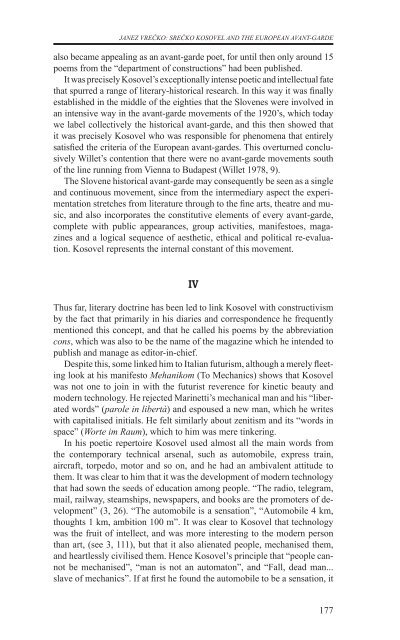razprave (pdf) - Društvo za primerjalno književnost - ZRC SAZU
razprave (pdf) - Društvo za primerjalno književnost - ZRC SAZU
razprave (pdf) - Društvo za primerjalno književnost - ZRC SAZU
- No tags were found...
Create successful ePaper yourself
Turn your PDF publications into a flip-book with our unique Google optimized e-Paper software.
Janez Vrečko: Srečko Kosovel and the European avant-gardealso became appealing as an avant-garde poet, for until then only around 15poems from the “department of constructions” had been published.It was precisely Kosovel’s exceptionally intense poetic and intellectual fatethat spurred a range of literary-historical research. In this way it was finallyestablished in the middle of the eighties that the Slovenes were involved inan intensive way in the avant-garde movements of the 1920’s, which todaywe label collectively the historical avant-garde, and this then showed thatit was precisely Kosovel who was responsible for phenomena that entirelysatisfied the criteria of the European avant-gardes. This overturned conclusivelyWillet’s contention that there were no avant-garde movements southof the line running from Vienna to Budapest (Willet 1978, 9).The Slovene historical avant-garde may consequently be seen as a singleand continuous movement, since from the intermediary aspect the experimentationstretches from literature through to the fine arts, theatre and music,and also incorporates the constitutive elements of every avant-garde,complete with public appearances, group activities, manifestoes, magazinesand a logical sequence of aesthetic, ethical and political re-evaluation.Kosovel represents the internal constant of this movement.IVThus far, literary doctrine has been led to link Kosovel with constructivismby the fact that primarily in his diaries and correspondence he frequentlymentioned this concept, and that he called his poems by the abbreviationcons, which was also to be the name of the magazine which he intended topublish and manage as editor-in-chief.Despite this, some linked him to Italian futurism, although a merely fleetinglook at his manifesto Mehanikom (To Mechanics) shows that Kosovelwas not one to join in with the futurist reverence for kinetic beauty andmodern technology. He rejected Marinetti’s mechanical man and his “liberatedwords” (parole in libertà) and espoused a new man, which he writeswith capitalised initials. He felt similarly about zenitism and its “words inspace” (Worte im Raum), which to him was mere tinkering.In his poetic repertoire Kosovel used almost all the main words fromthe contemporary technical arsenal, such as automobile, express train,aircraft, torpedo, motor and so on, and he had an ambivalent attitude tothem. It was clear to him that it was the development of modern technologythat had sown the seeds of education among people. “The radio, telegram,mail, railway, steamships, newspapers, and books are the promoters of development”(3, 26). “The automobile is a sensation”, “Automobile 4 km,thoughts 1 km, ambition 100 m”. It was clear to Kosovel that technologywas the fruit of intellect, and was more interesting to the modern personthan art, (see 3, 111), but that it also alienated people, mechanised them,and heartlessly civilised them. Hence Kosovel’s principle that “people cannotbe mechanised”, “man is not an automaton”, and “Fall, dead man...slave of mechanics”. If at first he found the automobile to be a sensation, it177
















